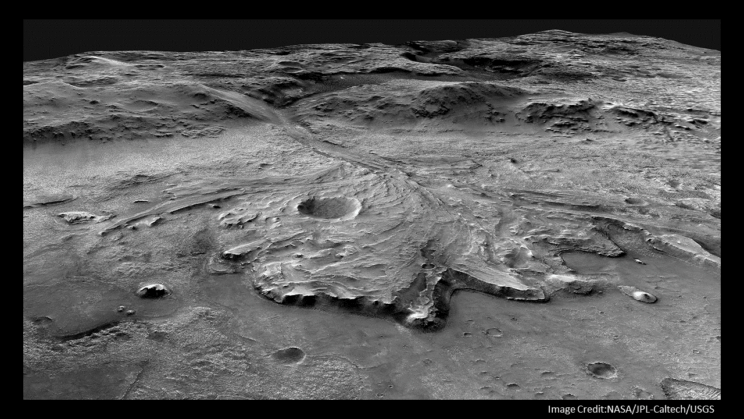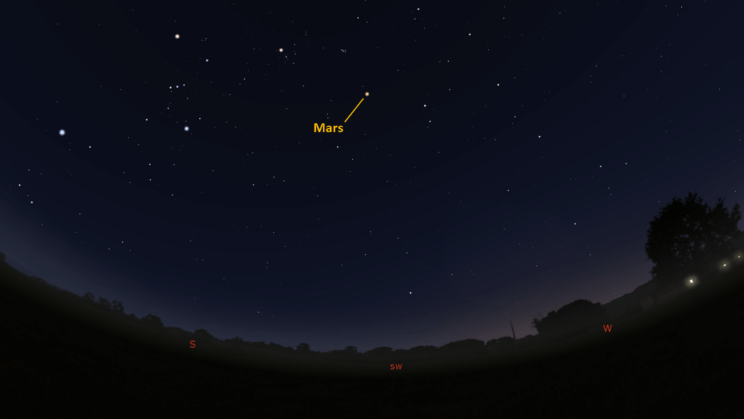This is the Saint Louis Science Center’s NIGHT SKY UPDATE for the week of Friday, February 12, 2021.
Information updated weekly or as needed.
Times given as local St. Louis time which is Central Standard Time (CST). For definitions of terminology used in the night sky update, click the highlighted text. If relying on times posted in Universal Time (UT), St. Louis is now -6 Hours from UT.
Public Telescope Viewings
Star parties at the Saint Louis Science Center have temporarily been canceled due to recommendations from the CDC regarding COVID-19. All public telescope events are canceled until further notice. As conditions change, we will reevaluate and update this article once public observing events resume.

Illustrated View of Perseverance Landing Site Inside Jezero Crater
Credit: NASA/JPL -Caltech/USGS
Observing Highlight of the Week
The observing highlight for this week is the planet Mars. Mars is at the tail end of the observing season for its current apparition. After March 10, Earth and Mars will be far enough apart that seeing details on its surface when using a telescope will not be likely. Mars is headed towards superior conjunction on October 7, 2021 which will officially end the current apparition. What this means for us is if you want to see the surface of Mars, get those last looks in because after March 10 we will have to wait until 2022 to see the surface of Mars again. This said, Mars will remain a naked eye target into August this year but as we head into September it will be lost to the Sun’s glare.
Aside from an observing update on Mars, I wanted to use Mars as the highlight this week because the Red Planet is set to receive a new visitor from NASA named Perseverance. This is NASA’s newest rover that is scheduled to land on February 18, 2021. It has taken Perseverance roughly 7 months to get to Mars and its primary mission is expected to last about 3 years.
Perseverance is headed to a 28-mile-wide crater called Jezero. Scientists believe this crater was once filled with water. Orbital studies indicate mineral deposits that suggest water involved chemistry making it a great place to look for signs that Mars may have supported life in its past. To date, there have been no discoveries that suggest life was ever on Mars, but Jezero crater is an interesting place to continue that pursuit.
The Perseverance mission has four main science goals. According to NASA these goals are:
- Geology: Study the rocks and landscape at its landing site to reveal the region’s history
- Astrobiology: Determine whether an area of interest was suitable for life, and look for signs of ancient life itself
- Sample Caching: Find and collect promising samples of Mars rock and soil that could be brought back to Earth in the future.
- Prepare for Humans: Test technologies that would help sustain human presence on Mars someday.
https://mars.nasa.gov/mars2020/mission/science/objectives/
NASA will be streaming live landing coverage from mission control on February 18 starting at 1:15 p.m. CST. The easiest way to see this coverage will be to tune into NASA TV on their YouTube channel. More information about this stream and other events leading up to landing on February 18 can be found at
https://mars.nasa.gov/mars2020/timeline/landing/watch-online/
The Sun and Moon

The Moon as seen from the International Space Station, on July 31, 2011.
Credit: NASA
Sunrise is at 6:55 a.m. on Friday, February 12 and sunset is at 5:36 p.m. providing us roughly 10.5 hours of daylight. Even after sunset, the light from the Sun will dimly illuminate our sky for about 1 hour and 30 minutes. This period is called twilight, which ends around 7:05 p.m. this week. For those with a sundial, local noon occurs around 12:16 p.m. this week.
| 2021-02-12 | 6:55 a.m. | 5:36 p.m. |
|---|---|---|
| 2021-02-13 | 6:54 a.m. | 5:37 p.m. |
| 2021-02-14 | 6:53 a.m. | 5:38 p.m. |
| 2021-02-15 | 6:52 a.m. | 5:39 p.m. |
| 2021-02-16 | 6:50 a.m. | 5:40 p.m. |
| 2021-02-17 | 6:49 a.m. | 5:42 p.m. |
| 2021-02-18 | 6:48 a.m. | 5:43 p.m. |
| 2021-02-19 | 6:47 a.m. | 5:44 p.m. |
| 2021-02-20 | 6:45 a.m. | 5:45 p.m. |
Moon
Moonrise for Friday, February 12 occurs at 7:48 a.m. and moonset will occur at 6:37 p.m. On Friday, February 12 the Moon will exhibit a waxing crescent phase with 1% of the lunar disk illuminated. First quarter moon occurs on February 19 at 12:47 p.m.
International Space Station (ISS) Observing

Visible passes of ISS from St. Louis for the week of February 12 occur during morning hours. The best passes this week occur on the mornings of February 18 and 20. Use the table below for information about these and other visible passes this week.
Catch ISS from St. Louis starting Friday, February 12
| Date | Starts | Max. altitude | Ends | |||||||
|---|---|---|---|---|---|---|---|---|---|---|
| Time | Alt. | Az. | Time | Alt. | Az. | Time | Alt. | Az. | ||
| 16 Feb | -0.7 | 06:13:23 | 10 | SSE | 06:15:29 | 16 | SE | 06:17:34 | 10 | E |
| 18 Feb | -2.8 | 06:13:51 | 10 | SSW | 06:17:06 | 49 | SE | 06:20:22 | 10 | ENE |
| 19 Feb | -1.7 | 05:26:50 | 10 | SSW | 05:29:44 | 27 | SE | 05:32:39 | 10 | ENE |
| 20 Feb | -1.1 | 04:41:32 | 15 | SSE | 04:42:25 | 16 | SE | 04:44:32 | 10 | E |
| 20 Feb | -3.5 | 06:15:39 | 10 | WSW | 06:18:55 | 50 | NW | 06:22:13 | 10 | NE |
Magnitude (Mag): The Measure of brightness for a celestial object. The lower the value is, the brighter the object will be.
Altitude (Alt): The angle of a celestial object measured upwards from the observer’s horizon.
Azimuth (Az): The direction of a celestial object, measured clockwise from an observer’s location with north being 0°, east being 90°, south being 180° and west being 270°.
For information about ISS flyovers and other visible satellites, visit www.heavens-above.com
Detailed information regarding all unmanned exploration of our universe, missions past, present, and planned, can be found at Jet Propulsion Laboratories:
The Visible Planets

Looking Southwest, at 6:30 pm, February 12, 2021
Credit: Stellarium, EG,
This week, one naked eye planet is visible. Mars is found high in the south after sunset. At the end of February, Saturn, Jupiter and Mercury will join the morning sky just before sunrise. This morning apparition for Mercury will not be great but the trio of planets will make for a challenging target to look for at the end of the month.
Mars
Currently Mars appears as a 0.7-magnitude object that will be visible high in the south about 30 minutes after sunset. Mars sets by 12:36 a.m. The observing season for this apparition ends around March 10, 2021 and superior conjunction occurs on October 7, 2021.
Uranus
Uranus is not a planet we normally include in this section. Even at its dimmest, the giant planet does hover within naked eye visibility. That said, it is so close to the visible limit of the human eye it just is not reality for most of us to see Uranus without binoculars or a telescope. You can find Uranus in the constellation Aries the Ram. The current magnitude for Uranus is 5.8. A finder chart for Uranus can be found here.
James S. McDonnell Planetarium
Night Sky Update: February 12-February 20, 2021






